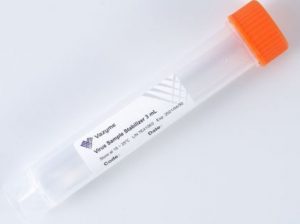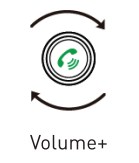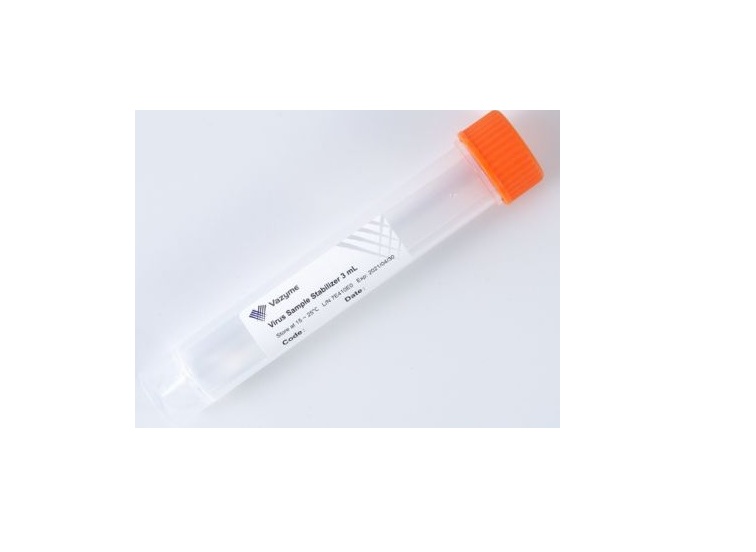Vazyme Virus Sample Stabilizer Instruction Manual

INTENDED USE
This product is applicable to specimen collection from human nasopharyngeal swab specimen and the preservation of viral nucleic acid.
WORKING PRINCIPLE
The sample stabilizer contains guanidine isothiocyanate and other protein denaturation reagents which can rapidly lyse cells and denature viral proteins to obtain the inactivated virus and release the nucleic acids of virus. The high concentration of guanidine salt in a suitable buffer solution can inhibit the nuclease activity and effectively protect the integrity of nucleic acids. The nuclease-free tube is treated with nuclease eliminator further ensuring the integrity of nucleic acid.
COMPONENTS
Virus sample stabilizer consists of Tris buffer, guanidine isothiocyanate, surfactant and nuclease-free water.
STORAGE & SHELF LIFE
Store at 15 ~ 25°C for 12 months.
SAMPLING REQUIREMENTS
- This product is suitable for the preservation of human nasopharyngeal swabs.
- For liquid specimens such as sputum, bronchial lavage and alveolar lavage fluids, it is recommended to use a wide-mouth tube (e.g. a 50 mL centrifuge tube) for collection; If using this product for specimen collection, it is important to avoid the contamination of the outer wall of the tube. Therefore, the volume of sample added in R513-01 should be less than 1 mL, the volume of sample added in R513-02 should be less than 2 mL.
PROTOCOL
- Collecting SpecimenFor the detailed methods of specimen collection, please refer to the protocol in the “Microbiology Specimen Collection Manual” and “Nursing Clinical Practice Guidelines”. For throat swab specimen, insert swab into the deep part of pharyngeal isthmus (both sides of uvula and tonsil), and rotate the swab several times against the wall of pharyngeal isthmus. For nasal swab specimen, insert swab into the deep part of the nasal cavity, and rotate the swab several times against the wall of nasal cavity.
- UsageImmerse the swab head in the sample stabilizer in the tube, carefully break and discard the swab shaft; then tighten the tube cap and put it into a disposable zip-lock bag. Confirm that the information of the storage tube and the zip-lock bag are consistent.Note: The disposable zip-lock bag is used to seal the sample after collection, which is convenient for transportation and disinfection operation before sample processing.
- TransportationKeep the tube cap facing up and place the tube in an upright vertical position in the sample collection container for transportation. Make sure that the swab head is not exposed and is immersed thoroughly in the sample stabilizer.
- StorageThe collected specimen should be used for detection as soon as possible. Otherwise, please store the specimen as follows. Store at 15 ~ 25°C for no more than 24 hours. Store at 2 ~ 8°C for no more than 72 hours.If collected specimen needs to be stored for more than 3 days, it is recommended to store it at -30 ~ -15°C; If there is no low-temperature freezing condition and the storage time is less than 7 days, it can be stored at 2 ~ 8°C.
- Inactivation TreatmentFurther inactivation treatment should be taken as required before extraction. For heat inactivation of SARS-CoV-2, it is recommended to incubate at 56°C for 30 min, and balance at room temperature for 10 min for avoiding aerosols.
- Extraction After inactivation treatment of specimen, gently stir and squeeze the swab, then remove the swab. And gently pipette to mix the sample stabilizer thoroughly.Perform the extraction procedure by different extraction products:Vazyme FastPure Viral DNA/RNA Mini Kit (Column based, #RC312): For the detailed protocol, please refer to the manual of #RC312.
- Aliquot 200 l of absolute ethanol to a new 1.5 mL of nuclease-free EP tube (additional consumable).
- Add 500 l of the above sample stabilizer to the tube containing absolute ethanol, then mix thoroughly by inverting the tube.
- Place the adsorption column in a 2 mL of collection tube and transfer the mixture to the adsorption column, cover the tube cap then centrifuge at 12,000 × g for 1 min.
- Discard the filtrate and reuse the collection tube. Add 600 l of Washing Buffer to the adsorption column, and centrifuged at 12,000 × g for 30 sec, discard the filtrate.
- Repeat Step 4 once.
- Place the adsorption column in a 2 mL of collection tube (reused), centrifuge empty adsorption column at 12,000 × g for 2 min.
- Transfer the adsorption column to a new 1.5 mL centrifuge tube (provided in the kit), add 50 l of Elution Buffer, incubate at room temperature for 1 min, centrifuge at 12,000 × g for 1 min.
- Discard the adsorption column, the eluted DNA/RNA can be used directly in downstream experiments or stored at -20°C for short-term storage, or stored at -70°C for long-term storage.Vazyme Virus DNA/RNA Extraction Kit (Magnetic Bead based, #RM102):
- For the detailed protocol, please refer to the manual of #RM102. 1. Aliquot 20 l of Proteinase K to a new 1.5 mL of nuclease-free EP tube (additional consumable).
- Add 200 l of the above sample stabilizer and 700 l of lysis solution (Make sure absolute ethanol has been added) to the tube containing Proteinase K, then mix thoroughly by vortexing gently or inverting the tube.
- Then add 20 l of magnetic beads to above mixture, vortex and mix for 15 sec.
- Incubate the above mixture at room temperature for 5 min; and invert the tube twice during this period.
- After brief centrifugation, place the samples on a magnetic stand. Wait until the solution clarifies (about 1 min). Keep on magnetic stand, and carefully discard the supernatant without disturbing the beads.
- Then operate the remaining steps according to the manual of the extraction kit. Add 700 l of Washing Buffer 1 and 700 l of Washing Buffer 2 respectively to rinse the beads. Then use the Elution Buffer to collect the nucleic acid into a new 1.5 mL of nuclease-free EP tube.
Use extraction products of other supplier:Treat the sample stabilizer as a specimen and operate the procedure according to the corresponding manual.
PRODUCT PERFORMANCE INDICATOR
- The package is intact; the appearance is neat, without leakage; and the sign is clear.
- PH value should be 7.0-7.2.
- The sample stabilizer is a colorless and transparent liquid with a volume of about 1.5 mL (R513-01) or 3 mL(R513-02).Note:
- It should be operated by professionally trained inspectors, read the product manual carefully before operation. Protective measures against infectious diseases should be took. Thorough sterilization must be done after operation of handling reagents and specimens.
- Even though this reagent can inactivate the virus, please treat the sample as the inactivated specimen and perform the treatment process carefully.
- This product is a disposable product.
- The involved specimen is considered as infectious substances, the operation and disposal must be complied with the relevant requirements of “the General Guidelines for Biosafety of Microbial Biomedical Laboratories” and “Medical Waste Regulations Guide”.
- The sample stabilizer contains guanidine salts of protein denaturant, which is corrosive. Please operate carefully. If it splashes onto the skin, please wash immediately with plenty of water.
- Sample stabilizer contains high concentration of guanidine salt, which can form precipitates or froze up when stored at 2~8°C or < 0°C. This is a normal phenomenon and does not affect the performance of the sample stabilizer. In this case the sample stabilizer should be redissolved before use.
REFERENCE
- Chevillard S. 1993. A method for sequential extraction of RNA and DNA from the sample, specially designed for a limited supply of biological material.Biotechniques. 15:2224.
CONTACTManufacturer: Nanjing Vazyme Medical Technology Co., Ltd. Address: Floor 1-3, Building C2, Red Maple Park of Technological Industry, Kechuang Road, Economy&Technology Development Zone, Nanjing, China Tel: +86 25 8436 5701 Customer Service Provider: Nanjing Vazyme Medical Technology Co., Ltd. Address: Floor 1-3, Building C2, Red Maple Park of Technological Industry, Kechuang Road, Economy&Technology Development Zone, Nanjing, China Tel: +86 25 8436 5701Web: http://www.vazyme.com/
DATE OF APPROVAL AND MODIFICATION
Symbols
| Authorized Representative | |
 |
For invitro diagnostic use only |
 |
Store between 15~25°C |
 |
Tests per kit |
 |
Catalog # |
 |
Lot Number |
 |
Manufacturer |
 |
Expire Date |
 |
Consult instructions for use |
References
[xyz-ips snippet=”download-snippet”]

